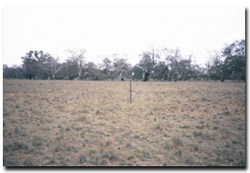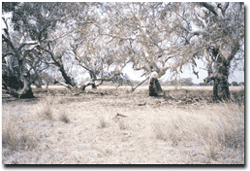Site 15 Tang Tang Swamp
Site is in environmental decline due to the spread of weed species and poor tree health.
Description
Tang Tang Swamp at an elevation of 105 metres, is one of only four such areas in the Loddon River dryland catchment and is at the northern most extremity of a chain of wetlands extending from Merin Merin and Middle Swamps at Clunes. Tang Tang Swamp is listed as Nationally significant, contains many Aboriginal archaeological sites and important habitat for rare, threatened and migratory bird species. Rare and vulnerable flora species are also present. A grazing licence was held at the swamp until 1998. The area is now managed by Parks Victoria and is carefully crash grazed in autumn and spring to control weeds in the grassland areas.
Vegetation Description and Composition Note: there are three vegetation quadrats surveyed at both wetlands monitored in the Loddon catchment. Parks Victoria assists with funding the additional vegetation surveys. The EVCs represented at Tang Tang Swamp are Red Gum Wetland dominated by Eucalyptus camaldulensis (Red Gum), Carex spp (sedge) and Eleocharis spp. (spike rush) and Plains Grassland dominated by a mixture of native grasses including: Danthonia spp., (Wallaby Grass) and Stipa spp., (Spear grass). Tang Tang swamp in its entirety has remained dry since spring 2001. A very small puddle near the depth gauge was recorded in winter 2002. Inundation of the vegetation quadrats during spring 1997 and 1998 caused a huge reduction in annual weed species and an increase in native aquatic species. However prolonged dry conditions has seen the re-establishment of introduced species from the Poaceae (grass) and Asteraceae Families. |  Grassland quadrat at Tang Tang Swamp |
The vrot Maireana humillima (Dwarf Bluebush) was recorded in 2002, as were three salt indicator species being Lolium spp. (Rye grass), Critesion marinum (Sea Barley grass) and Lolium rigidum (Wimmera Rye grass). Soil tests need to be performed to determine whether salinity levels are increasing across the site.
Tree Health
Eight are monitored for tree canopy health using a 20-point system assessing canopy size and density, number of dead branches and extent of epicormic growth. Leaf damage by insects is also assessed. Tree health at the swamp is declining with many experiencing reduced canopy densities, extensive epicormic growth and insect attack.
Two of the monitored trees are now almost dead. Prolonged dry conditions are causing severe drought stress in these trees, however it is almost certain that saline water tables are affecting Tang Tang Swamp. Tandarra Pondage, less than 2km south from the swamp is a huge water storage held for irrigation purposes, and the pressure of this water is pushing the surrounding water table closer to the surface. Tree dieback is clearly evident along the Bendigo/Piccaninny Creek due west from the pondage and it appears to be slowly creeping northward toward Tang Tang Swamp.
Water Quality Tang Tang Swamp has remained dry since spring 2001 (except for a tiny puddle recorded in winter 2002). Two macroinvertebrate surveys have been conducted at the swamp in 1997 and 2000 and found that there was a relatively large taxa richness when compared to other wetlands across the state. Several pollution and salinity sensitive families were recorded, suggesting a relatively high level of biological health. Some general observations recorded so far were the water quality was generally very good in relation to dissolved oxygen, pH and conductivity levels, but nutrient concentrations often exceeded maximum limits for the prevention of eutrophication (nutrient enrichment). The swamp often contains only a few centimetres of water and this would be an important factor in high nutrient and turbidity readings. |  Tree health is generally quite poor at the swamp |
Groundwater and salinity
There are seven bores monitored in the vicinity of Tang Tang Swamp and all have displayed a falling groundwater trend in response to dry seasonal conditions. Depths to groundwater and salinity concentrations in 2002 varied from 3.0-5.5 metres and 4000-32000 EC respectively. The water table is close to the surface given the dry conditions and the groundwater is very saline, so therefore the swamp is at risk from dryland salinity if levels were to rise any further.
Birds
Bird species seen at the time of vegetation and tree health surveys include:-
Brown Falcon, Galah, Magpie, Masked Woodswallow, Red-rumped Parrot
White-browed Woodswallow (numbering in 100’s), Superb Fairy Wren, Willie Wagtail, Crested Pigeon, Corella, Magpie, Kookaburra, Little Raven, Welcome Swallow, Yellow Tufted Honeyeater, Striated Pardalote and Magpie Lark.
Site Threats
- continued weed invasion with floodwaters eg. Juncus acuta Spiny Rush.
- possible return of stock grazing for “fire risk management.”
- increased nutrient levels.
- possible incorrect water regime.


